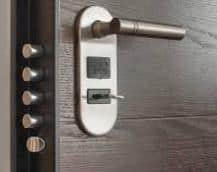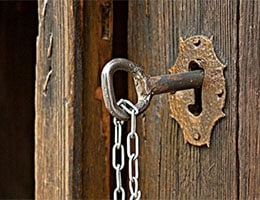 The concept of a lock refers to a metal mechanism that allows something to be closed through latches that match a key . Locks can be found on doors, boxes, chests and other objects.
The concept of a lock refers to a metal mechanism that allows something to be closed through latches that match a key . Locks can be found on doors, boxes, chests and other objects.
For example: "The thief forced the lock to enter the victim's home ," "The lock on my car broke with the crash," "Don't even dream of checking my things: I put a lock on the drawer."
What a lock does is make it impossible to open something unless you have the corresponding key. Most locks are mechanical : they feature cylinders with keys that have points or teeth. When the person inserts the key into the keyhole and turns it, the play necessary to unlock the lock mechanically is produced.
There are also electronic locks . In this case, to achieve opening it is necessary to activate an electromagnet by entering a code or a magnetic card. These locks are common in hotel rooms and on doors that enter an area restricted to the general public.
Time locks, lastly, work on a timer . The lock is lifted only when a certain period elapses or when a previously selected time is reached.
As you can see, there are multiple types of locks. The choice of one or the other depends on the element that you intend to keep closed: protecting the treasury door of a bank is not the same as protecting the drawer of a domestic closet.
The history of the lock as a concept to protect private property goes back a few centuries, when humans began to use a wooden pin that was attached horizontally behind the door and slid so that it crossed a hollow structure in which it was stuck to prevent the door from opening.
 Already at the time of the lock based on said wooden pin, an element was used that acted as a key, to be able to unlock it from the outside; In this case it was a curved metal object with a straight handle that was entered through a hole and allowed the pin to be moved out of the hitch. Precisely, to lock the pin, a wedge was used, which was lifted with the help of the key.
Already at the time of the lock based on said wooden pin, an element was used that acted as a key, to be able to unlock it from the outside; In this case it was a curved metal object with a straight handle that was entered through a hole and allowed the pin to be moved out of the hitch. Precisely, to lock the pin, a wedge was used, which was lifted with the help of the key.
The ancient Egyptians, for example, used this design although they added more wedges to increase safety. The Romans, for their part, managed to reduce the pin, which they made of bronze, in addition to shrinking the pins and pressing them with the help of a spring .
It took a long time until lock designs similar to those we know today began to appear. We are talking about the 18th century, when in England the progress in construction techniques for security systems could be seen. However, the English did not stay on top for long, as in 1851 an American locksmith named Alfred Hobbs defiantly announced that he would be able to unlock any English lock, while no British locksmith would be able to do the same with any English lock. yours; and, as the story goes, he was right.
Two other American figures contributed considerably to the sophistication of locks: Linus Yale and his son of the same name. They worked for decades to perfect security systems. His achievements include obtaining the patent for bank locks and the invention of the combination (or secret quadrant ). His success was such that for a long time his surname was considered practically synonymous with the term "key."
